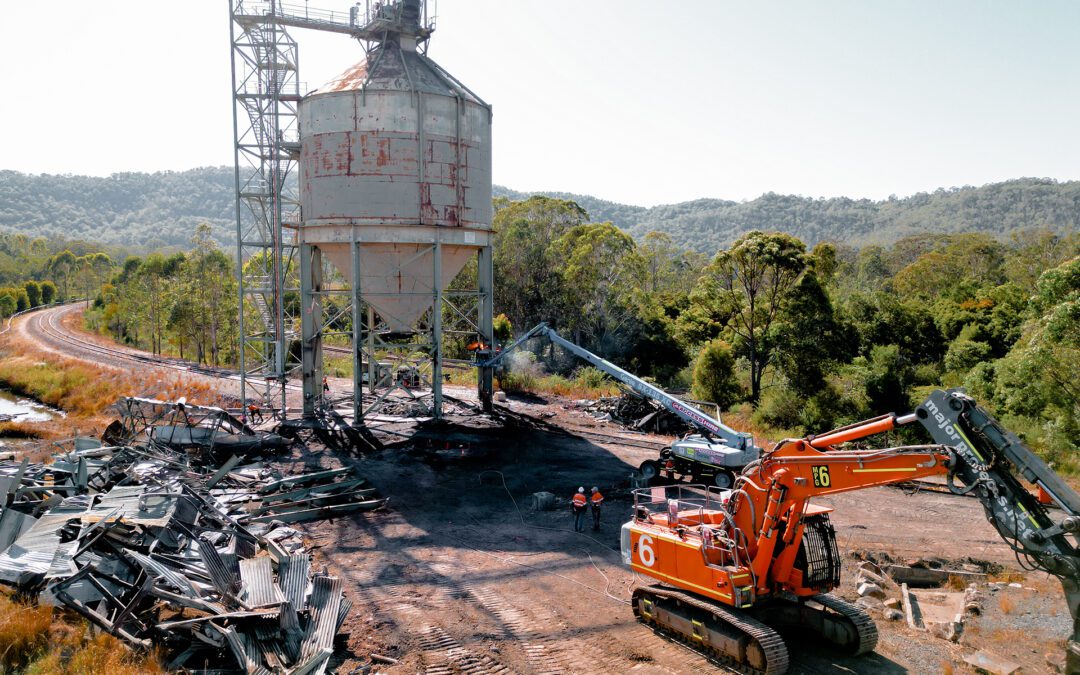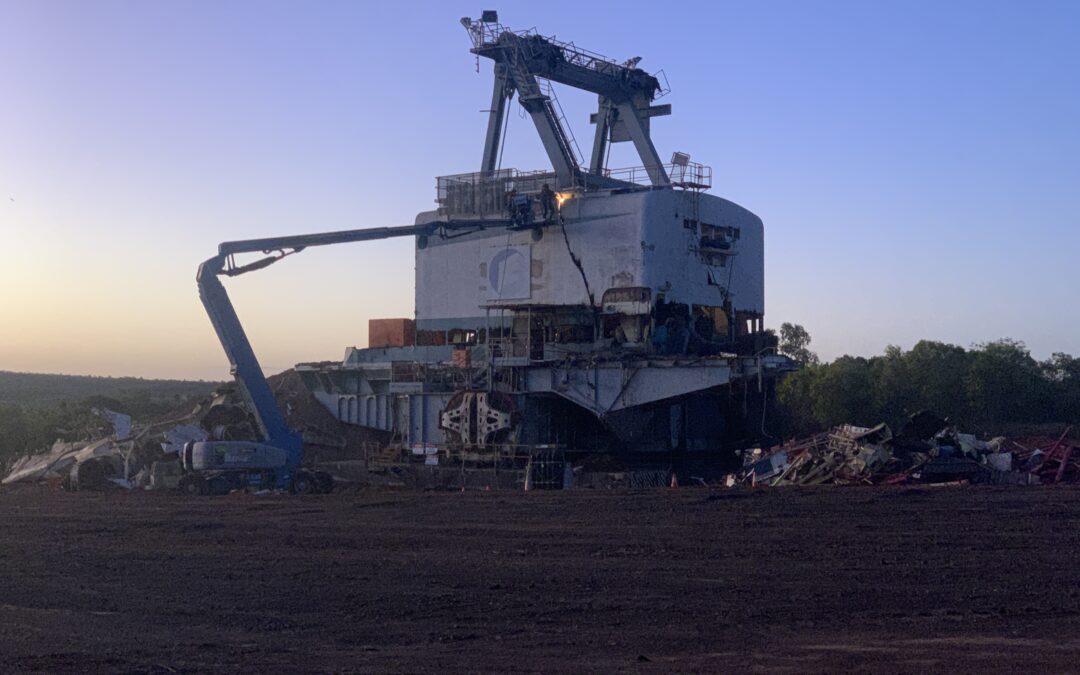Guide to chemical plant demolition

Planning a chemical plant demolition? Whether due to business closure, subpar safety standards or any other reason, shutting down such a high-risk facility demands careful decommissioning, decontamination and disposal processes.
From major independent facilities to smaller plants within wider operations, worker safety and environmental compliance are paramount during any chemical plant demolition. This is because they process hazardous materials, many of which can be toxic, explosive or in some other way detrimental to their surroundings if handled incorrectly.
Below, we explain how to decontaminate, demolish and dispose of plant infrastructure. Read on to discover the key factors to consider for a safe, cost-effective and successful outcome.
Risk assessments for a chemical plant demolition
These analyses flag potential hazards to the surrounding environment and personnel based on the project’s unique factors. However, to give you an idea, typical risks include chemical spills, exposure to toxic substances and worker injuries.
This risk assessment is key to informing the demolition plan, and therefore should include:
- An engineering assessment to assess structural integrity and design;
- An electrical assessment to map out the power supply throughout the site and any isolation requirements;
- A fire assessment to determine the fire prevention and control measures needed during decontamination and demolition;
- Work health and safety assessment to address the effects of demolition on surrounding personnel and establish emergency protocols;
- A hazardous material (HAZMAT) inspection to confirm the type and location of all hazardous materials present, including asbestos; and
- A site survey to examine the structure itself and any potential environmental risks onsite.
Importantly, a risk assessment for chemical plant demolition should detail all on-site chemicals and their hazards, such as whether they are flammable, corrosive or toxic. It should also note the quantities and types of wastes produced by decommissioning, decontamination and demolition activities.
Decommissioning and decontamination
Before demolition begins, the chemical plant will be decommissioned. Industrial plant decommissioning entails shutting down operations and removing any in-process or raw materials. These can include lubricants, refrigerants, transformer oils, polychlorinated biphenyls, and radioactive substances.
Please note that most chemical suppliers refuse returns, due to quality and safety concerns. Therefore, removing excess chemicals can be costly and challenging. If they are going to be incinerated, you will need to send samples for testing, prepare formal bid documents and meet strict transport requirements.
For example, the chemicals might have to be loaded in drums or tank trucks, which in turn could necessitate temporary infrastructure like piping, as well as new protocol development.
Importantly, decontamination must also take place before demolition to prevent environmental pollution and minimise safety hazards. This process removes undesirable chemical entities both on and inside plant equipment through washing, heating, chemical treatment and mechanical cleaning techniques.
The four main categories of contaminants are:
- Solids e.g. products and residues.
- Liquids e.g. residual substances in tanks, pumps, reactors and heat exchangers.
- Vapours e.g. volatile chemicals in storage tanks and pipes.
- Aerosols e.g. powders and dusts.
The decontamination process aims to:
- Minimise personnel’s exposure to hazardous materials;
- Salvage as much equipment and materials as possible;
- Remediate the site for future use; and
- Meet all waste transport and disposal regulations.
Decontamination can occur naturally through exposure to air and water over an extended period of time. However, a more systematic approach is required after demolition, such as controlled chemical, water and/or steam treatment.
Finally, any liquid and solid waste generated by decontamination processes will be disposed of using a standardised procedure that depends on the chemical plant’s regulations.
During this stage, your demolition contractor can also manage the abatement of asbestos, mercury, lead and other high-risk materials. At Major Projects, we leverage over 40 years of industry experience to deliver end-to-end asbestos and hazard material removal services.
Chemical plant demolition
In this case, demolition involves the dismantling or destruction of fixed or moveable structures on a chemical plant site. That includes buildings, equipment and infrastructure.
Depending on its design, contents and surroundings, each structure will be carefully demolished using mechanical, explosive, high-reach or induced collapse techniques. This work is often completed in stages, during which structures may need to undergo another round of decontamination.
Learn more about the demolition process.
Waste disposal
You have several options when dealing with the broken-up structures that follow a chemical plant demolition. These materials can be removed completely or kept for future applications.
More specifically, it is possible to arrange the:
- Total disposal of dismantled or demolished components;
- Partial disposal of dismantled or demolished components (with remaining parts salvaged for re-use or assembled at a new location); or
- Relocation of dismantled components to another site;
Effluent and chemical waste should only be disposed of once you have obtained consent from the environmental authorities. Furthermore, if any wastes are intended for landfill, their sampling, testing, storage and transport require meticulous planning.
With so many technicalities and regulations to consider, it is important to engage a chemical plant demolition contractor who will ensure all demolition waste has been disposed of safely and efficiently. At Major Projects, our team has the expertise, permits and licences to handle this critical stage of chemical demolition.
Site restoration after chemical plant demolition
Environmental remediation refers to rehabilitating the land and restoring it to its condition prior to chemical plant activities. Once all structures have been demolished, subsurface testing should be performed to determine whether environmental remediation is required.
This is often a crucial step in chemical plant demolition, particularly for larger, standalone chemical plants on land that may become brownfield sites. These are old sites that have been used for industrial purposes in the past and are likely to have been contaminated as a consequence.
Site restoration can include anything from stormwater sewer installation and road construction to tree planting and soil treatment.
Additionally, any demolished materials should be decontaminated before disposal to prevent pollution and re-contamination of the surrounding environment.
Such activities allow for all sorts of future use, from development to rewilding.
Chemical plant demolition in action
Major Projects Group recently completed the demolition of a 40-year-old battery recycling plant in Alexandria, New South Wales. This extensive 1.7-hectare facility was used for battery breaking, acid neutralisation and component storage.
Including one main building, multiple outer buildings and a 46m-high stack, the site was located in a commercial area just 5kms from Sydney CBD. These busy surroundings brought significant challenges, such as limited space and stringent dust control legislation.
First, we used a 30t Liebherr LH-30 excavator to demolish the chemical plant’s walls and over 4,000m2 of metal roof sheets. Then the concrete structures were demolished by a second 29t excavator with a hammer attachment.
Next, it was time to remove the stack. Given its proximity to neighbouring buildings, we dismantled this structure in three separate sections using two large cranes.
Throughout the demolition, water suppression lowered dust levels generated from our metal and concrete removal works, as well as onsite vehicles.
We completed this large-scale project to schedule, with zero incidents and minimal disturbance to its surroundings. Plus, all materials were removed and recycled, leaving a clear site for future development.
Explore more chemical plant demolition projects.
Enquire about chemical plant demolition with Major Projects Group
Chemical plant demolition comprises several key stages, including decommissioning, disposal and land remediation. To ensure a safe, compliant and cost-effective result, you need a reliable demolition contact with expertise in all of these areas.
As a proud Social Enterprise leading environmental stewardship in the demolition sector, Major Projects Group uses the latest equipment and certified HSEQ management systems to perform complex industrial demolitions across Australia.
We offer a full range of capabilities, such as decommissioning, dismantling, demolition, asset recovery and asbestos and hazardous material removal – all with minimal impact on the surrounding communities and ecosystem.
To begin your chemical plant demolition with Major Projects Group, please enquire today at +61(0)2-4967-7900 or [email protected].

















